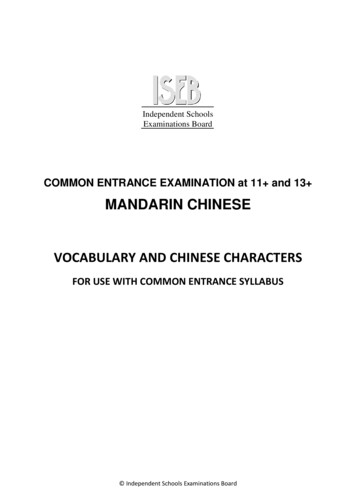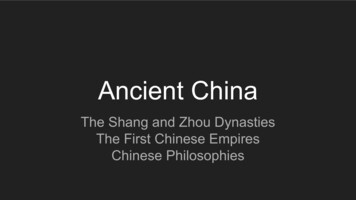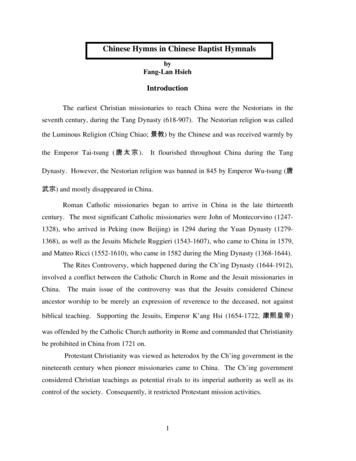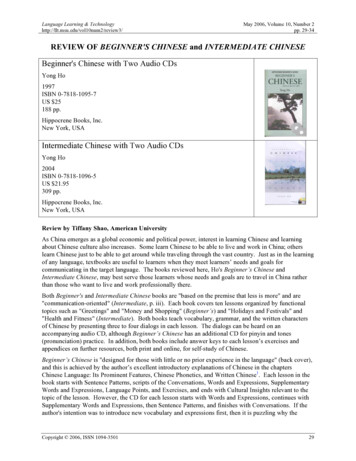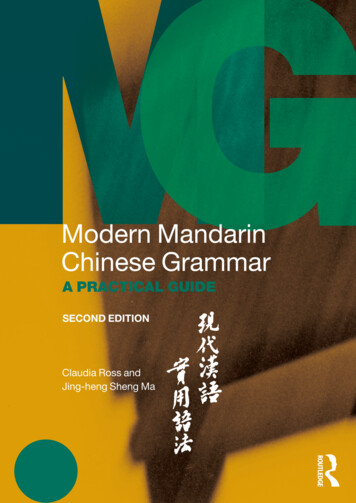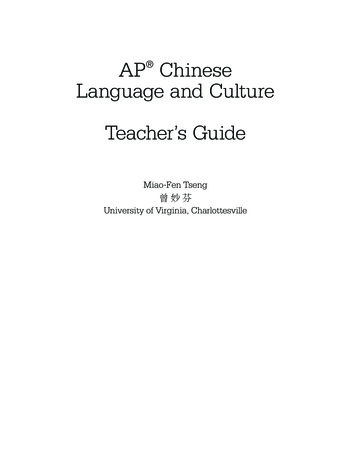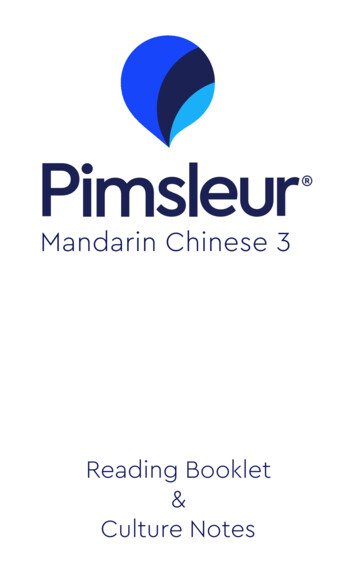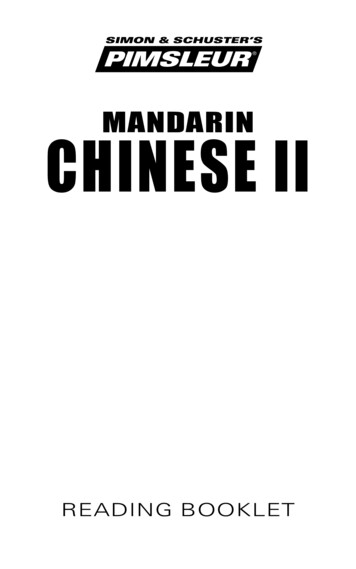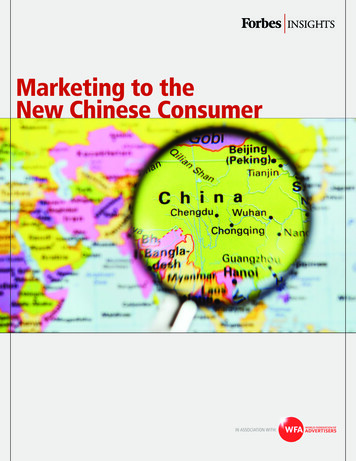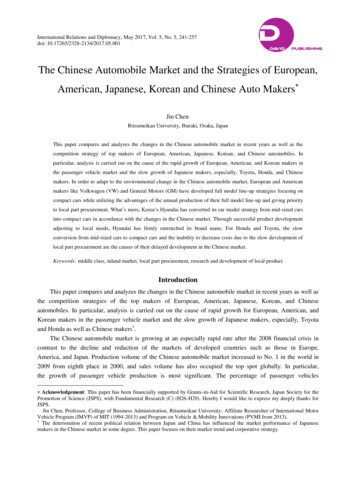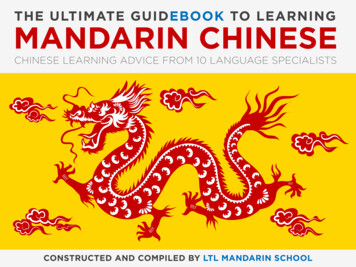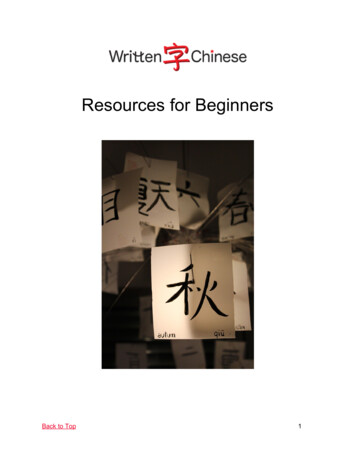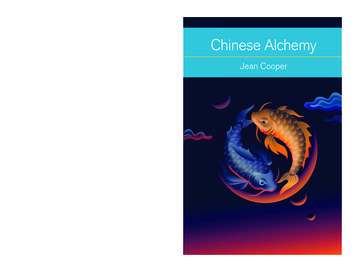
Transcription
Here in one slender volume are the essentials to a tradition that datesback thousands of years. Among the topics covered are:The origins of Chinese alchemyThe quest for gold and immortalityThe role of minerals and plants, medicines, astrology,yoga, and magic in Chinese alchemyAlchemy in the East and in the WestJ. C. Cooper describes the history and development of Taoist alchemy,compares it with similar traditions in India and Turkistan, and gives itcontext by contrasting it with the rationale of the Western hermetictradition. As she writes in her concluding chapter:“The whole work of alchemy is summed up in the phrase ‘To make of thebody a spirit and of the spirit a body’ . . . The goal of the Taoist alchemistmystic was transformation, or perhaps more correctly, transfiguration,of the whole body until it ceases to ‘be’ and is absorbed intoand becomes the Tao.”www.redwheelweiser.comISBN: 978-1-57863-577-1U.S. 14.95Cover design: Graham LesterCooperChinese alchemy, largely associated with Taoism, has a recorded history ofmore than 2,000 years, but traditionally it goes back even further, to theYellow Emperor and his Three Immortal Ladies, circa 3000 BC.Chinese AlchemyAn essential guide toChinese legend and lore,Chinese magic and medicine and TaoismChinese AlchemyJean Cooper
This edition first published in 2016 by Weiser Booksan imprint of Red Wheel/Weiser, llcWith offices at:65 Parker Street, Suite 7Newburyport, MA 01950www.redwheelweiser.comCopyright 2016 by J. C. CooperAll rights reserved. No part of this publication may be reproduced or transmitted in any form or by any means, electronic or mechanical, includingphotocopying, recording, or by any information storage and retrieval system,without permission in writing from Red Wheel/Weiser, llc. Reviewers mayquote brief passages. Originally published in 1984 by Aquarian Press, a partof the Thorsons Publishing Group, ISBN: 1-85030-327-3.ISBN: 978-1-57863-577-1Library of Congress Cataloging-in-Publication DataNames: Cooper, J. C. (Jean C.) author.Title: Chinese alchemy : Taoism, the power of gold, and the quest forimmortality / J.C. Cooper.Description: San Francisco : Weiser Books, 2016. Includes bibliographicalreferences and index.Identifiers: LCCN 2015042587 ISBN 9781578635771 (5 x 7.75 pbk. : alk.paper)Subjects: LCSH: Taoism--China. Alchemy.Classification: LCC BL1923 .C66 2016 DDC 299.5/14--dc23LC record available at http://lccn.loc.gov/2015042587Cover design by Graham LesterText design by Jane HagamanPrinted in the United States of AmericaM&G10 9 8 7 6 5 4 3 2 1Chinese Alchemy Final Pages.indd 43/29/16 10:15 AM
—1—ORIGINSThere is little in Chinese alchemy that cannot be associated withTaoism and although the exact origins of that alchemy may still bein dispute in t h e light of present incomplete evidence, it is not questioned that it grew and was nourished in the soil of popular and religious Taoism. It is also recognized that there are two distinct branchesof Taoism: the classical Tao Chia, the mystical, metaphysical aspect,stemming from Lao Tzu and Chuang Tzu, and the popular, religious, magical, alchemical side, the Tao Chiao, which arose traditionally with the Yellow Emperor and his Three Immortal Ladies, or Maids,who taught him magic, mysticism and love. Lao Tzu and ChuangTzu probably represented a movement against these earlier animistic-magico practices and founded the Tao Chia as a protest, or rather acorrection, at a time when such practices had lost their original meaning and become loaded with superstition.Yet another viewpoint is that classical Taoism was original but wastoo austere and rarefied for the general populace and later, meetingthe shamanism which flourished in the tribes of the regions north andwest of China proper, absorbed shamanistic-animistic lore and degenerated into the religious, ritualistic, magical and alchemical branch,the Tao Chiao, which fulfilled the day-to-day needs of the people andwhich still exists in modern times as a popular religion. Thus, frombeing abstract philosophy, it became a concrete religion with a ceremonial Church, having a priesthood, liturgy and theology, a Pope, and aTrinity known as the Three Pure Ones. From the original non-theisticmysticism it became not only theistic but polytheistic, adopting thepantheon of popular Buddhism.While the origins and dates of Chinese alchemy are still beingresearched and debated (there are literally hundreds of Taoists texts asyet untranslated) it is known for certain that it flourished well before144 BC, for at that date the Emperor issued an edict which ordered public execution for anyone found making counterfeit gold. The making ofcounterfeit cash was also proscribed. However, in the year 60 BC theChinese Alchemy Final Pages.indd 13/29/16 10:15 AM
then Emperor appointed a well-known scholar, Liu Hsiang, as Master of the Recipes so that he could make alchemical gold and prolongthe Emperor’s life. He failed to make the gold and so was disgraced.This points to an already well-established and widespread practice inalchemy. It was also said to have been practised in the fourth centuryBC by Tsou Yen, who had a reputation as a miracle-worker and a following among the aristocracy. He was also reputed to have been the firstalchemist to combine the search for the Elixir with the search for gold.The Later Han dynasty (AD 25-220) was a time of great interest inscience, astronomy, botany, zoology and medicine and in this periodthere appeared the first book on alchemy, the Ts’an T’ung Ch’i of WeiPo-yang. Its date was about AD 142 and its title is translated as ‘TheBook of the Kinship of the Three,’ but it was written in terms which weretoo difficult for the understanding of all but initiates. But most of thealchemical texts derive from the T’ang dynasty (AD 618-960), whichmaintained this interest, especially in the alchemical branch of Taoism.The language of the Ts’an T’ung Ch’i being too complicated and esoteric to be of general use, it is to Ko Hung that we must turn for the earliest complete treatise. He lived about AD 260 to 340 and is regardedas the most famous of writers on Chinese alchemy. He is supposed tohave written several hundred books but his known work is the Pao P’uTzu nei p’ien, usually referred to as the Pao P’u Tzu, though this was,in fact, a pseudonym he adopted and can be translated as ‘The Masterwho preserves his pristine simplicity,’ which has also been renderedas ‘Old Sobersides.’ The work is in two parts, the nei p’ien, comprising some twenty scrolls, and the wei p’ien, some fifty. He says: ‘My neip’ien, telling of gods, genii, prescriptions and medicines, ghosts andmarvels, transformations, maintenance of life, extension of years, exorcising evils and banishing misfortune, belongs to the Taoist school. Mywei p’ien, giving an account of success and failure in human affairs and ofgood and evil in public affairs, belongs to the Confucian school.’1It was Ko Hung who was responsible for the delightful definitionsof classical Taoism and Confucianism. He was asked: ‘Of Confucianism and Taoism, which is the more difficult?’ He replied: ‘Confucianism is difficulty in the midst of facility; Taoism is facility in the midstof difficulties; in it all annoyances are lifted with an inner harmonythat grows of itself; perfect freedom of action and thought; no fear,2 Chinese AlchemyChinese Alchemy Final Pages.indd 23/29/16 10:15 AM
no grief.’ Taoists ‘reject specialization in worldly matters, wash awayall trickeries, forget wealth and neglect honours, block repression andencourage free expression, are not concerned about the loss of anything, do not glory in success and are not saddened by denigration andtake no delight in praise.’Ko Hung regarded the existing scrolls for medicines as incomplete,confused and often lacking in treatment for many critical illnesses. Hesaid that they employed expensive ingredients only available to therich, whereas his scrolls would be found to mention all the medicinesand give full treatment for all serious illnesses: ‘Any household possessing this book can dispense with the services of a physician. Further, it isnot always possible to find a physician at a moment’s notice and whenyou do find one he may not wish to come immediately.’ (This strangelymodern passage was written nearly 2000 years ago!)Chinese alchemy, being more concerned with longevity andimmortality than with the making of gold, was naturally involvedwith finding the Elixir of Immortality and with prescriptions for prolonging life. When challenged that he was attempting the impossible in trying to overcome mortality in this life, Ko Hung replied thatalthough the deaf could not hear thunder or appreciate music, andthe sun and the splendour of the Emperor’s robes were invisible tothe blind, it did not mean that these things did not exist. His recipefor long life was the use of appropriate medicines, breathing exercisesand philosophical thought. Alchemy, like all esoteric lore, had to belearned from an adept and Ko Hung’s master, Cheng Yin, at overeighty, had black hair, a ‘full cheerful face’ and could draw a strongcross-bow and shoot a hundred paces; he walked hundreds of milesand could drink two demijohns of wine without becoming drunk; heclimbed mountains with agility and crossed precipitous places anddangerous heights which daunted younger men. He ate and drank thesame things as anyone else, but could go for unlimited days withoutfood and without feeling hunger.In his writings Ko Hung maintained that alchemical change was onlyone facet of the universal transformations in Nature. ‘It is clear, therefore, that transformation is something spontaneous in Nature. Why thenshould we demur at the possibility of making gold and silver from otherthings? Look at the fire obtained from heaven with the burning-mirror,Origins 3Chinese Alchemy Final Pages.indd 33/29/16 10:15 AM
and the water got at night [dew] from the moon-mirror; are they different from ordinary fire and water? . . . I guarantee that mercury canvapourize and that gold and silver can be sought successfully . . . theManuals of the Immortals tell us . . . that it is in the nature of gold and silver that one can make them.’ In his time there were treatises which contained recipes and formulae for ‘melting jade,’ ‘transforming gold’ andmaking ‘talisman water.’ But these obscure and probably esoteric termsnotwithstanding, Professor Needham, the great authority on the development of Chinese science, says that Ko Hung’s Pao P’u Tzu ‘containssome scientific thinking at what appears to be a high level.’Ko Hung disapproved of the recluse-alchemists seeking their ownimmortality to the neglect of their dependents, as so many did: ‘Toturn one’s back upon wife and children and make one’s abode in themountains and marshes, uncaringly to reject basic human usage . . .is hardly to be encouraged. If by some good fortune they can becomeimmortal and still go on living at home, why should they seek tomount specially to the heavens?’ Once the preparation of the divineElixir has been achieved successfully ‘you and your whole household,not just you alone, will become immortals.’ He also says that this stateof immortality cannot be attained without good deeds, loyalty, friendliness and trustworthiness.This condition of immorality was known as that of the hsien, thegenie or immortal, and the alchemist aimed at achieving hsien-hood,of which there were several grades, as will be seen later. Strangely, KoHung’s death was said to be consistent with the lowest grade, the shihchieh hsien, the ‘corpse free,’ one whose corpse disappears, leaving onlythe clothes or some identifying object behind. At his death he wasencoffined but later it was found that his body had disappeared, onlyhis clothes remaining.While Ko Hung, Wei Po-yang and other early alchemists can betraced in historical records, many of the early names and the stagesof alchemy are found only in legend, for which the Chinese have thedelightful phrase ‘wild history.’ The most important of these legendarycharacters is undoubtedly the Yellow Emperor, Huang Ti, who traditionally reigned from about 2704 to 2595 BC. He was regarded as thefirst and greatest of Taoist immortals and alchemists and was said tohave learned, not only from his Three Immortal Maids, but also from4 Chinese AlchemyChinese Alchemy Final Pages.indd 43/29/16 10:15 AM
Chang Tao-ling founder of the popular Taoism and the first Taoist popean Immortal who lived on a mountain, who, after considerable persuasion, instructed the Emperor in the understanding of the Tao, ofsciences, meditation and medicines. Huang Ti was reputed to havewritten the Inner Classics. He became an Immortal, or hsien, himselfand after reigning for over a hundred years he ascended to heaven onthe back of a dragon, taking with him some seventy members of hisdomestic household and court, in full view of the populace. OthersOrigins 5Chinese Alchemy Final Pages.indd 53/29/16 10:15 AM
of his retainers, anxious to go heavenward with him, hung on to thewhiskers of the dragon, but they gave way and the hangers-on, togetherwith the Emperor’s bow, fell to the ground. The people gazed at theEmperor and dragon until they disappeared into the heavens. Thefallen bow was collected and venerated. Although there was a tomband a shrine built for the Yellow Emperor it was said that it was laterfound to be devoid of a corpse and contained only a sword and shoes.Another legendary character was the Emperor YÜ the Great, traditionally known as ‘the happy miner.’ He was a smelter who ‘piercedthe mountains’ and ‘made the earth healthy.’ He knew the differencebetween male and female metals and employed the yin-yang principlesin all his work, dividing his cauldrons into yin and yang. There werenine of these, four yin and five yang. Here it is of interest to note theearly appearance of the yin-yang doctrine, the importance of the number nine, which runs throug
Chinese Alchemy Cooper Here in one slender volume are the essentials to a tradition that dates back thousands of years. Among the topics covered are: The origins of Chinese alchemy The quest for gold and immortality The role of minerals and plants, medicines, astrology, yoga, and magic in Chinese alchemy Alchemy in the East and in the West Chinese alchemy, largely associated with Taoism,
